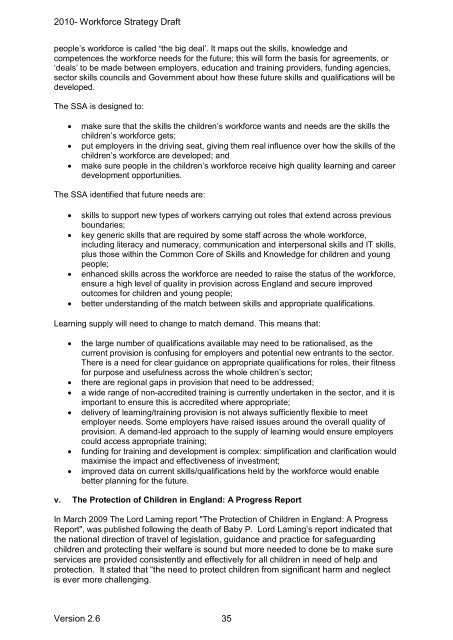Proposed structure for the Children and Young People's Workforce ...
Proposed structure for the Children and Young People's Workforce ...
Proposed structure for the Children and Young People's Workforce ...
- No tags were found...
You also want an ePaper? Increase the reach of your titles
YUMPU automatically turns print PDFs into web optimized ePapers that Google loves.
2010- Work<strong>for</strong>ce Strategy Draftpeople’s work<strong>for</strong>ce is called ‘<strong>the</strong> big deal’. It maps out <strong>the</strong> skills, knowledge <strong>and</strong>competences <strong>the</strong> work<strong>for</strong>ce needs <strong>for</strong> <strong>the</strong> future; this will <strong>for</strong>m <strong>the</strong> basis <strong>for</strong> agreements, or‘deals’ to be made between employers, education <strong>and</strong> training providers, funding agencies,sector skills councils <strong>and</strong> Government about how <strong>the</strong>se future skills <strong>and</strong> qualifications will bedeveloped.The SSA is designed to:• make sure that <strong>the</strong> skills <strong>the</strong> children’s work<strong>for</strong>ce wants <strong>and</strong> needs are <strong>the</strong> skills <strong>the</strong>children’s work<strong>for</strong>ce gets;• put employers in <strong>the</strong> driving seat, giving <strong>the</strong>m real influence over how <strong>the</strong> skills of <strong>the</strong>children’s work<strong>for</strong>ce are developed; <strong>and</strong>• make sure people in <strong>the</strong> children’s work<strong>for</strong>ce receive high quality learning <strong>and</strong> careerdevelopment opportunities.The SSA identified that future needs are:• skills to support new types of workers carrying out roles that extend across previousboundaries;• key generic skills that are required by some staff across <strong>the</strong> whole work<strong>for</strong>ce,including literacy <strong>and</strong> numeracy, communication <strong>and</strong> interpersonal skills <strong>and</strong> IT skills,plus those within <strong>the</strong> Common Core of Skills <strong>and</strong> Knowledge <strong>for</strong> children <strong>and</strong> youngpeople;• enhanced skills across <strong>the</strong> work<strong>for</strong>ce are needed to raise <strong>the</strong> status of <strong>the</strong> work<strong>for</strong>ce,ensure a high level of quality in provision across Engl<strong>and</strong> <strong>and</strong> secure improvedoutcomes <strong>for</strong> children <strong>and</strong> young people;• better underst<strong>and</strong>ing of <strong>the</strong> match between skills <strong>and</strong> appropriate qualifications.Learning supply will need to change to match dem<strong>and</strong>. This means that:• <strong>the</strong> large number of qualifications available may need to be rationalised, as <strong>the</strong>current provision is confusing <strong>for</strong> employers <strong>and</strong> potential new entrants to <strong>the</strong> sector.There is a need <strong>for</strong> clear guidance on appropriate qualifications <strong>for</strong> roles, <strong>the</strong>ir fitness<strong>for</strong> purpose <strong>and</strong> usefulness across <strong>the</strong> whole children’s sector;• <strong>the</strong>re are regional gaps in provision that need to be addressed;• a wide range of non-accredited training is currently undertaken in <strong>the</strong> sector, <strong>and</strong> it isimportant to ensure this is accredited where appropriate;• delivery of learning/training provision is not always sufficiently flexible to meetemployer needs. Some employers have raised issues around <strong>the</strong> overall quality ofprovision. A dem<strong>and</strong>-led approach to <strong>the</strong> supply of learning would ensure employerscould access appropriate training;• funding <strong>for</strong> training <strong>and</strong> development is complex: simplification <strong>and</strong> clarification wouldmaximise <strong>the</strong> impact <strong>and</strong> effectiveness of investment;• improved data on current skills/qualifications held by <strong>the</strong> work<strong>for</strong>ce would enablebetter planning <strong>for</strong> <strong>the</strong> future.v. The Protection of <strong>Children</strong> in Engl<strong>and</strong>: A Progress ReportIn March 2009 The Lord Laming report "The Protection of <strong>Children</strong> in Engl<strong>and</strong>: A ProgressReport", was published following <strong>the</strong> death of Baby P. Lord Laming’s report indicated that<strong>the</strong> national direction of travel of legislation, guidance <strong>and</strong> practice <strong>for</strong> safeguardingchildren <strong>and</strong> protecting <strong>the</strong>ir welfare is sound but more needed to done be to make sureservices are provided consistently <strong>and</strong> effectively <strong>for</strong> all children in need of help <strong>and</strong>protection. It stated that “<strong>the</strong> need to protect children from significant harm <strong>and</strong> neglectis ever more challenging.Version 2.6 35
















